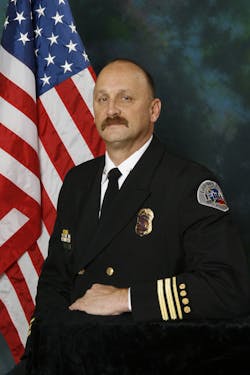We usually think of fire departments and police departments as separate entities, but frequently, municipalities will combine both resources under the heading of a “Public Safety Department.” This combination allows for the sharing of facilities, personnel and equipment. One of the most beneficial, yet often overlooked, capabilities is the sharing of the fire department’s thermal imaging resources.
Applications where a TI can be used by law enforcement officers include surveillance, search and rescue, and scene assessment. TIs have been used to locate contraband in hidden containers, truck tires or car-door panels. The image on the TI displays thermal irregularities that help provide investigators with important clues to finding the hidden items. Accident investigations can be aided by using a TI as well. For instance, a police officer responds to a car accident with the driver unconscious and the backseat door opened. Using a TI to scan the backseat would show a heat spot on the seat if someone had been sitting there. If that were the case, then the officer would need to search the surrounding area for an injured person. TIs are also used to find evidence that has been thrown in bushes or on the side of the road.
Night vision vs. thermal imaging
Before we go any further, let’s consider the differences between night vision and thermal imaging. Night vison magnifies existing light and enhances imagery. Thermal imaging detects heat signatures or infrared energy that is not affected by light unless a lighting source directly affects surface temperature. In the past, night vision became the mainstay in the law enforcement community as thermal imaging did in the fire service.
It’s important to note that there are very obvious and technical reasons why one can utilize a TI designed for the rigors of the fire service in a law enforcement application, and yet law enforcement imagers cannot be deployed for use in structural fire attack. The concepts of durability, insulating thermal protection, progressive warning colorization schemes, fixed-focus lenses and “white hot” all play well in the fire arena. A TI designed for law enforcement would suffer premature and catastrophic failure in such adverse operating environments. In all likelihood, your local fire department is more inclined to have these imaging capabilities as the industry continues to adopt smaller and lower-cost imagers.
A search example
Consider receiving a call from your law enforcement agency at 2:00 a.m. They are requesting help to find an individual who has fled from the police. This suspect was last seen shoeless and shirtless and heading into a dense swampy area filled with underbrush surrounded by high, muddy water from relentless rains. Quickly, this incident turned from a minor offense to one of concern for the health and welfare of the suspect.
During the search, officers used the TI to scan the shoreline for the suspect but realized after a couple hours that they needed to expand their search. The officers requested additional TIs from the fire department. The initial TI search located transformers, power lines and heat signatures from parked police cars, rocks and trees still warm from the sun. Just when the officers thought they had covered the entire area, the TI picked up an image. It was the suspect who was found outside the immediate search area.
The safe apprehension of a fleeing suspect is always a first priority of law enforcement, and not being able to quickly locate the individual provided an opportunity to deploy additional TIs from the fire department. The first question could easily be, “Why did the officers wait so long to deploy additional TIs?” The truth is conventional thought processes and procedures often blind us to consider the unconventional or that which is not routine.
Has this ever happened to you? You respond to a chimney fire, and you are so concerned about fire extension and physically inspecting the structure that you completely forget you had the TI on scene. We are all guilty of being occasionally stuck in a specific mindset, so let this article be a reminder that your TI is valuable for many more applications than interior fire attack and overhaul.
Share the technology
We are all aware that there is a strong and common bond that exists between the fire service and law enforcement. Both professions ultimately protect and serve the general public. It only makes sense that they share this common tool of thermal imaging as well.
About the Author

Carl Nix
Carl Nix is a 30-year veteran of the fire service. He is currently the battalion chief of the Grapevine, TX, Fire Department, an adjunct instructor for North Central Texas College and a Thermal Imaging instructor for Bullard. Nix holds a bachelor’s degree in fire administration and serves as a guest instructor for Texas A&M Engineering Extension Service’s (TEEX) annual fire training in Texas. He can be reached at [email protected].
